(第三讲)使用JUnit对Spring Boot中的Rest Controller进行单元测试
(第三讲)使用JUnit对Spring Boot中的Rest Controller进行单元测试
本次教程主要讲解如何对Spring Boot中的Rest Service进行单元测试。以往我们主要是使用JUnit对业务层进行单元测试,本次课程将使用一个简单的案例来说明如何使用JUnit对Spring Boot的Rest Service进行单元测试。
1. 主要类容
- 快速搭建Restfull Service 环境
- 创建GET请求以检索用户信息
- 创建GET请求检索用户角色信息
- 创建POST请求新增用户角色信息
- 如何使用PostMan请求Restfull Service
- 使用JUnit对GET请求进行单元测试
- 使用JUnit对POST请求进行单元测试
2. 你将需要准备的工具
- JDK 1.8及以上版本
- Maven 3.0及以上版本的项目构建工具
- IDEA代码编辑器
3. 你可以通过以下的地址获取本次课程的所有示例代码
https://github.com/ramostear/Spring_Boot_2.X_Tutorial/tree/master/spring-boot-junit-rest-service
4. 项目结构
下面通过一张截图来了解以下本次课程中我们使用到的项目结构。
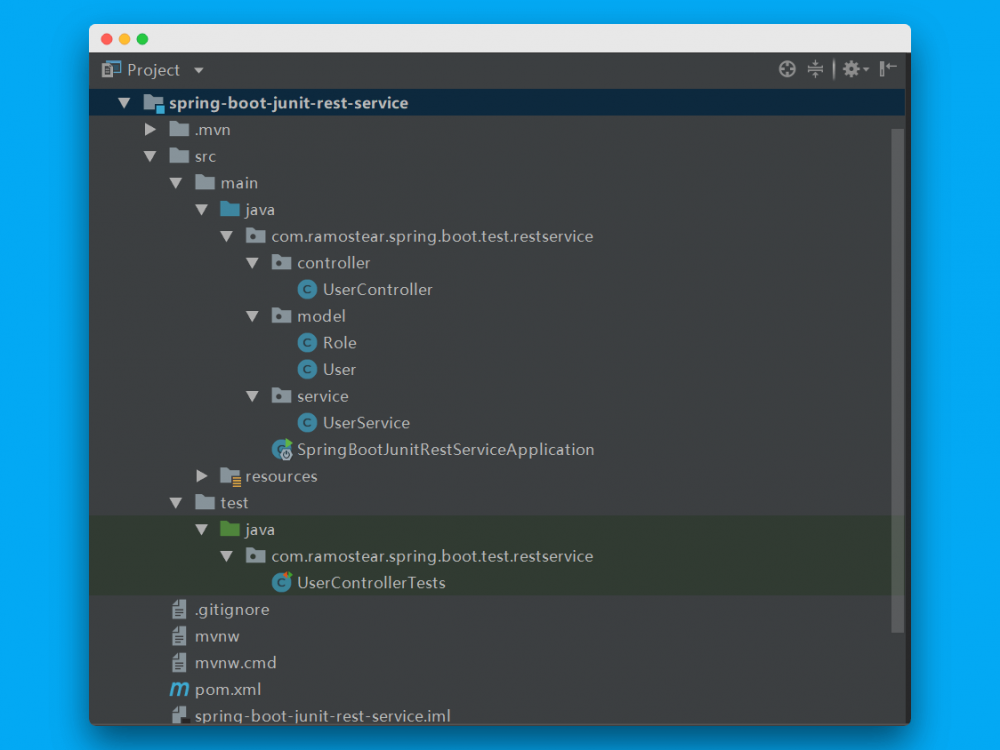
首先我们需要位单元测试提供一个可用的Rest Controller。UserController文件为我们提供了一个可用于测试的Rest Controller。在UserController类中,我们提供两种请求类型的方法,一种是GET请求,另一种是POST请求。然后我们为这两种请求方式的方法编写单元测试用例。
在接下来的测试过程中,我们将使用Mockito来模拟请求UserService的过程,使用MockMvc来模拟请求UserController。单元测试的目的是将测试范围尽可能的缩小。在本次案例中,我们仅对UserController中的方法进行测试。
5. 初始化项目
我们依然使用Spring Initializr来初始化本次课程的项目,你需要配置如下图中的参数:
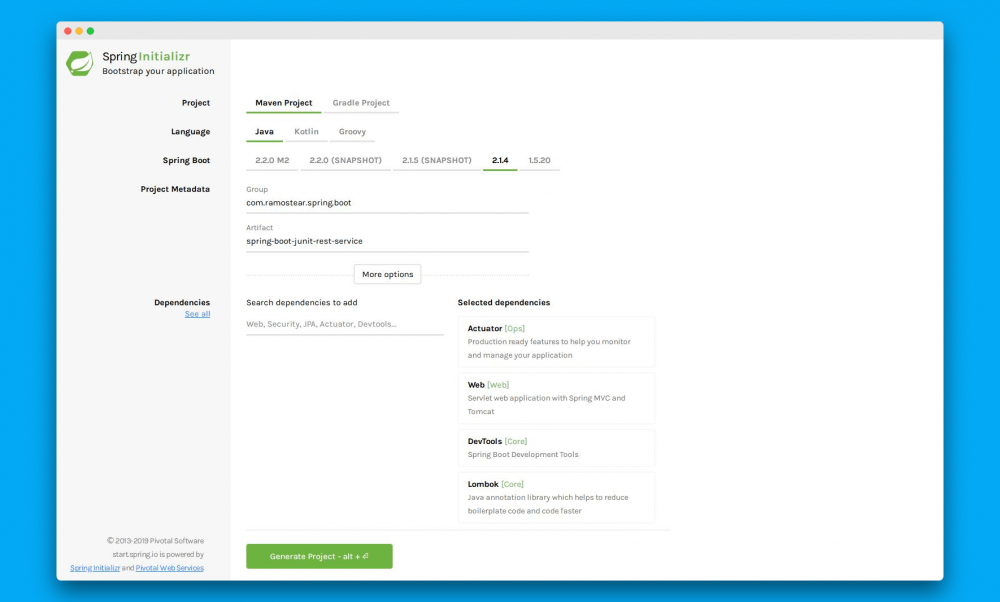
现在我们需要提供两个实体类:User和Role:
User.java
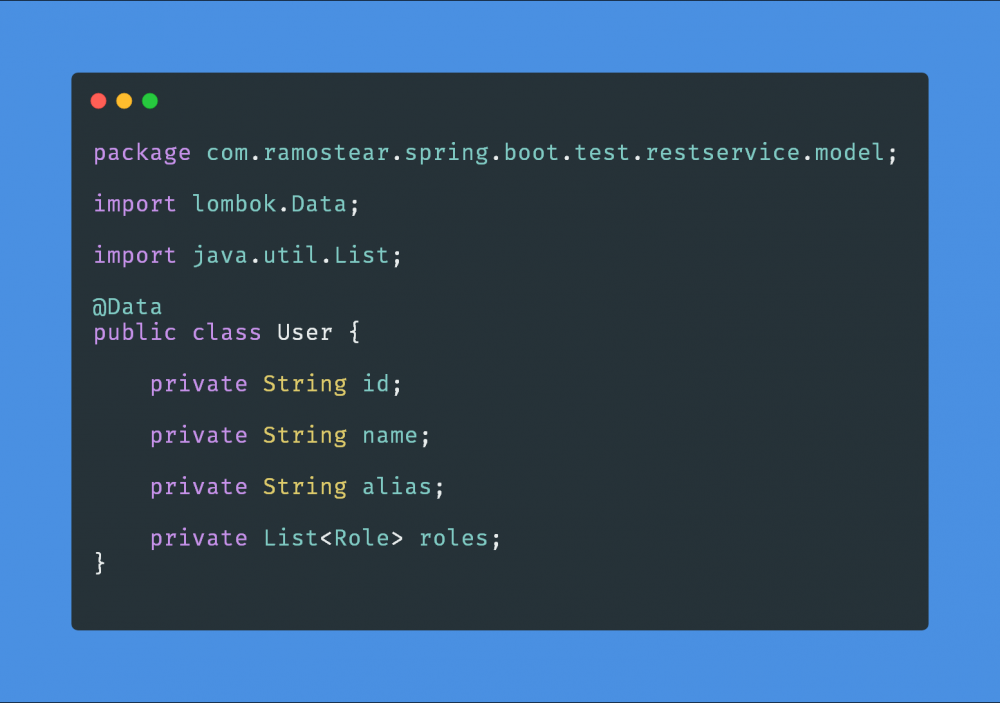
Role.java
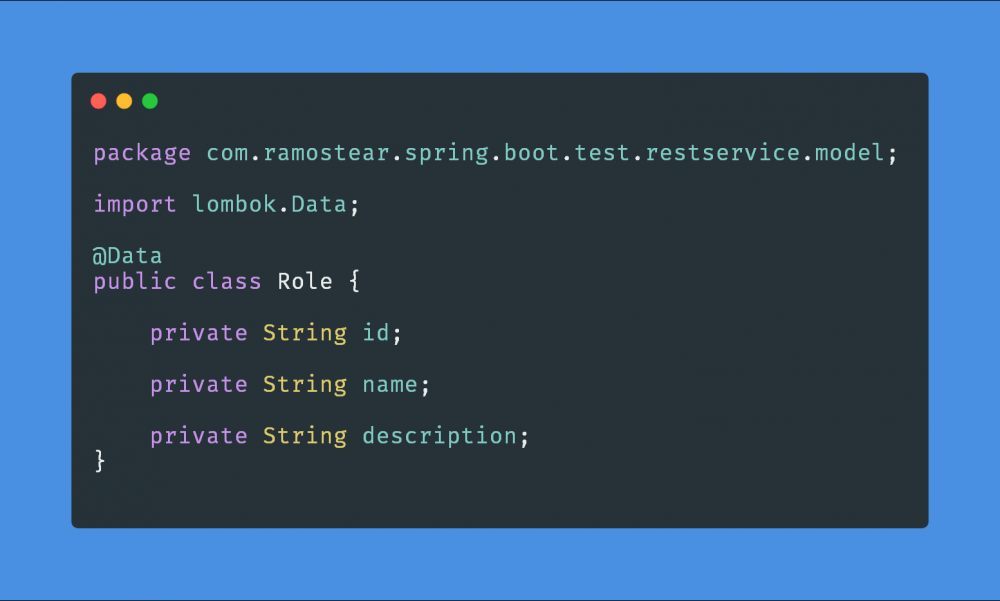
6. 提供可用的业务服务
所有的应用都需要有数据的存储,本次课程主要的重点是为了Rest Controller的单元测试,因此使用ArrayList来充当数据库的角色。在案例中,一个用户可以有多个角色,一个角色也可以被赋予给多个用户。用户有ID,名字,别名和角色列表,角色具有ID,名称和描述。在UserService类中,将提供如图所示的公共方法。
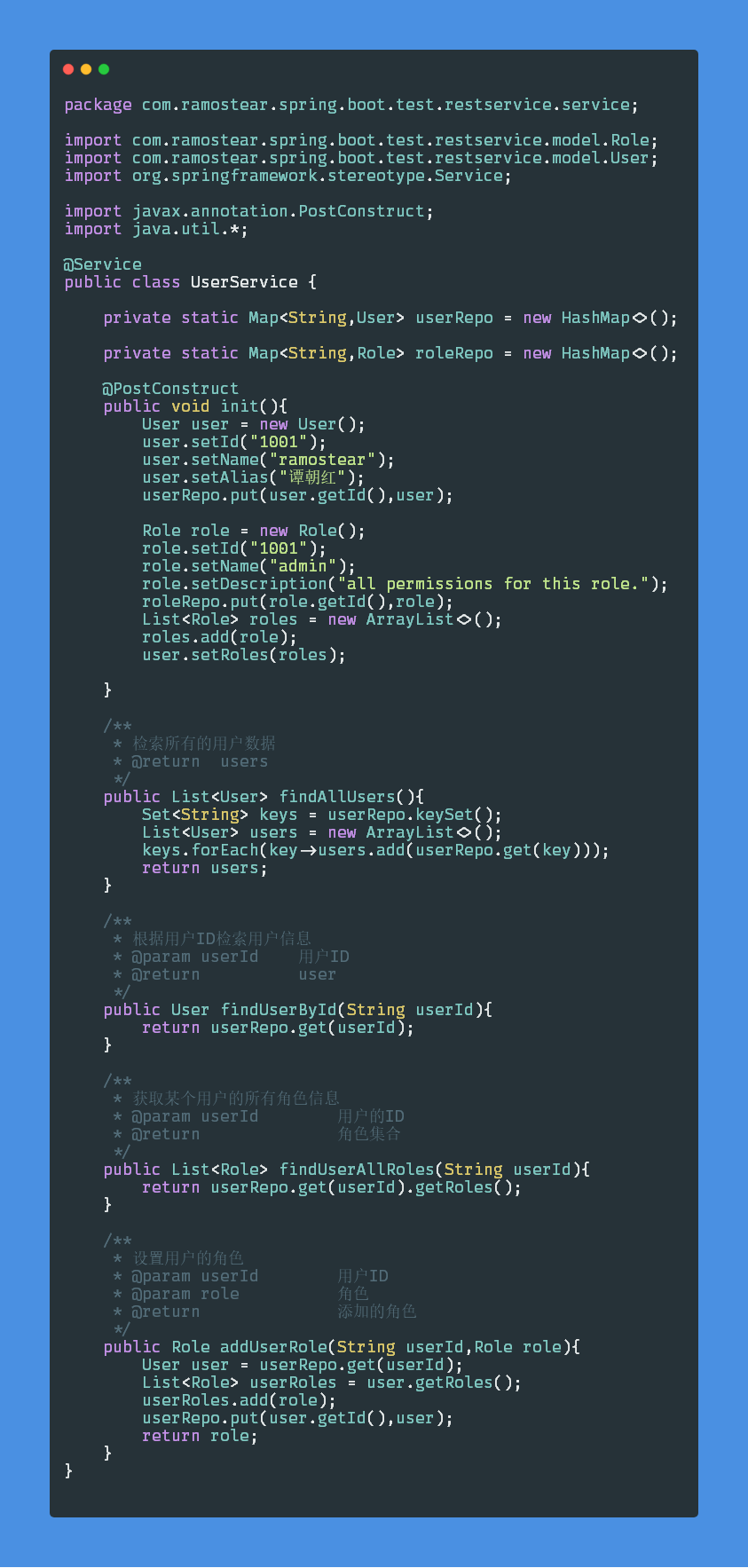
7. 提供GET请求方法
在UserController类中,我们将提供如下几个公开的GET请求方法:
- @GetMapping(value="/users") : 获取所有的用户信息
- @GetMapping(value="/users/{id}/roles") : 根据用户ID获取该用户的所有角色信息
UserController.java类中的详细代码如下:
package com.ramostear.spring.boot.test.restservice.controller;
import com.ramostear.spring.boot.test.restservice.model.Role;
import com.ramostear.spring.boot.test.restservice.model.User;
import com.ramostear.spring.boot.test.restservice.service.UserService;
import org.springframework.beans.factory.annotation.Autowired;
import org.springframework.http.HttpStatus;
import org.springframework.http.ResponseEntity;
import org.springframework.web.bind.annotation.*;
import java.util.List;
@RestController
public class UserController {
private final UserService userService;
@Autowired
public UserController(UserService userService){
this.userService = userService;
}
@GetMapping(value = "/users")
public List<User> findAllStudents(){
return userService.findAllUsers();
}
@GetMapping(value = "/users/{id}/roles")
public List<Role> findUserRoles(@PathVariable(value = "id")String id){
return userService.findUserAllRoles(id);
}
}
8. 使用Postman对RestController进行测试
我们将使用Postman工具对上述两个Rest API进行请求,首先向Postman地址栏输入 http://localhost :8080/users 进行测试,获得的响应信息如下:
[
{
"id": "1001",
"name": "ramostear",
"alias": "谭朝红",
"roles": [
{
"id": "1001",
"name": "admin",
"description": "all permissions for this role."
}
]
}
]
下图显示了Postman对此API进行测试的实际结果:
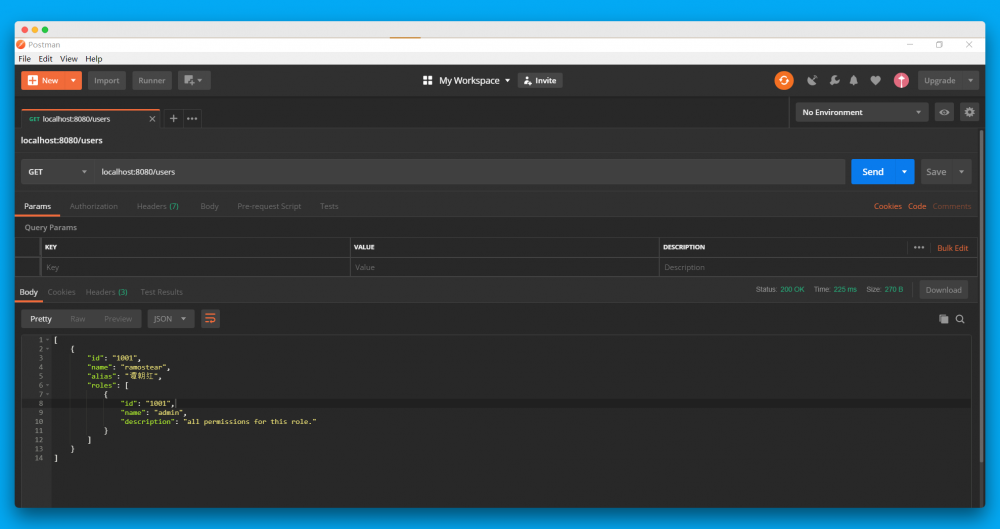
9. 为RestController编写单元测试
当我们需要对一个Rest Controller进行单元测试时,我们只想启动和SpringMVC相关的组件,而不必要启动所有的Web组件。我们可以使用WebMvcTest注解来解决这样的测试需求。此注解将禁用Spring Boot的自动化配置,仅仅启动与MVC相关的配置。下面将对测试用例中的几个核心注解做一下介绍:
- @RunWith(SpringRunner.class) : SpringRunner是SpringJUnit4ClassRunner的简写,它扩展了BlockJUnit4ClassRunner类,用于提供测试时的Spring应用上下文信息。
- @WebMvcTest(value=UserController.class,secure = false) : 该注解用于测试Spring MVC应用程序,使用此注解的好处是我们只需要加载UserController类并对其中的方法进行单元测试,而不需要加载其他的控制器。
- MockMvc : MockMvc是测试Spring MVC应用程序的主要入口,它将为我们的测试提供一个模拟的应用上下文环境。
- @MockBean : MockBean主要是模拟向Spring应用上下文注入一个Bean对象,并使该Bean对象可以在控制器中被访问到。
下面是测试用例的源代码:
package com.ramostear.spring.boot.test.restservice;
import com.ramostear.spring.boot.test.restservice.controller.UserController;
import com.ramostear.spring.boot.test.restservice.model.Role;
import com.ramostear.spring.boot.test.restservice.model.User;
import com.ramostear.spring.boot.test.restservice.service.UserService;
import org.junit.Assert;
import org.junit.Test;
import org.junit.runner.RunWith;
import org.mockito.Mockito;
import org.skyscreamer.jsonassert.JSONAssert;
import org.slf4j.Logger;
import org.slf4j.LoggerFactory;
import org.springframework.beans.factory.annotation.Autowired;
import org.springframework.boot.test.autoconfigure.web.servlet.WebMvcTest;
import org.springframework.boot.test.mock.mockito.MockBean;
import org.springframework.http.HttpStatus;
import org.springframework.http.MediaType;
import org.springframework.mock.web.MockHttpServletResponse;
import org.springframework.test.context.junit4.SpringRunner;
import org.springframework.test.web.servlet.MockMvc;
import org.springframework.test.web.servlet.MvcResult;
import org.springframework.test.web.servlet.RequestBuilder;
import org.springframework.test.web.servlet.request.MockMvcRequestBuilders;
import java.util.ArrayList;
import java.util.List;
@RunWith(SpringRunner.class)
@WebMvcTest(value = UserController.class,secure = false)
public class UserControllerTests {
private static Logger logger = LoggerFactory.getLogger(UserControllerTests.class);
@Autowired
private MockMvc mockMvc;
@MockBean
private UserService userService;
@Test
public void findAllUsers() throws Exception{
User user = new User();
user.setId("1001");
user.setName("ramostear");
user.setAlias("谭朝红");
Role role = new Role();
role.setId("1001");
role.setName("admin");
role.setDescription("all permissions for this role.");
List<Role> roles = new ArrayList<>();
roles.add(role);
user.setRoles(roles);
List<User> users = new ArrayList<>();
users.add(user);
Mockito.when(userService.findAllUsers()).thenReturn(users);
RequestBuilder requestBuilder = MockMvcRequestBuilders.get("/users");
MvcResult result = mockMvc.perform(requestBuilder).andReturn();
String expected = "[{/"id/":/"1001/",/"name/":/"ramostear/",/"alias/":/"谭朝红/",/"roles/":[{/"id/":/"1001/",/"name/":/"admin/",/"description/":/"all permissions for this role./"}]}]";
logger.info(result.getResponse().getContentAsString());
JSONAssert.assertEquals(expected,result.getResponse().getContentAsString(),false);
}
@Test
public void findAllUserRoles() throws Exception{
Role role = new Role();
role.setId("1001");
role.setName("admin");
role.setDescription("all permissions for this role.");
List<Role> roles = new ArrayList<>();
roles.add(role);
Mockito.when(userService.findUserAllRoles("1001")).thenReturn(roles);
RequestBuilder requestBuilder = MockMvcRequestBuilders.get("/users/1001/roles");
MvcResult result = mockMvc.perform(requestBuilder).andReturn();
String expected = "[{/"id/":/"1001/",/"name/":/"admin/",/"description/":/"all permissions for this role./"}]";
logger.info(result.getResponse().getContentAsString());
JSONAssert.assertEquals(expected,result.getResponse().getContentAsString(),false);
}
}
mockMvc.perform().andReturn():mockMvc主要用于执行请求并返回响应数据
下面我们执行上述两个方法,看看测试结果:

两个方法均测试通过,且控制台也输出了如下的日志信息:
2019-05-10 05:36:40.567 INFO 18268 --- [ main] c.r.s.b.t.r.UserControllerTests : [{"id":"1001","name":"admin","description":"all permissions for this role."}]
2019-05-10 05:36:40.585 INFO 18268 --- [ main] c.r.s.b.t.r.UserControllerTests : [{"id":"1001","name":"ramostear","alias":"谭朝红","roles":[{"id":"1001","name":"admin","description":"all permissions for this role."}]}]
10 . 添加POST请求方法
现在我们在Rest Controller中新增一个为用户添加新角色的方法,当角色被成功设置后将返回状态码为201的一个创建资源状态。代码如下:
@PostMapping(value = "/users/{id}")
public ResponseEntity<Object> setUserRole(@PathVariable(value = "id")String id, @RequestBody Role role){
userService.addUserRole(id,role);
return new ResponseEntity<>(role, HttpStatus.CREATED);
}
使用Postman对此接口进行请求,获得如下的响应信息:
{
"id": "1002",
"name": "editor",
"description": "content editor"
}
下图时使用Postman请求的实际结果:
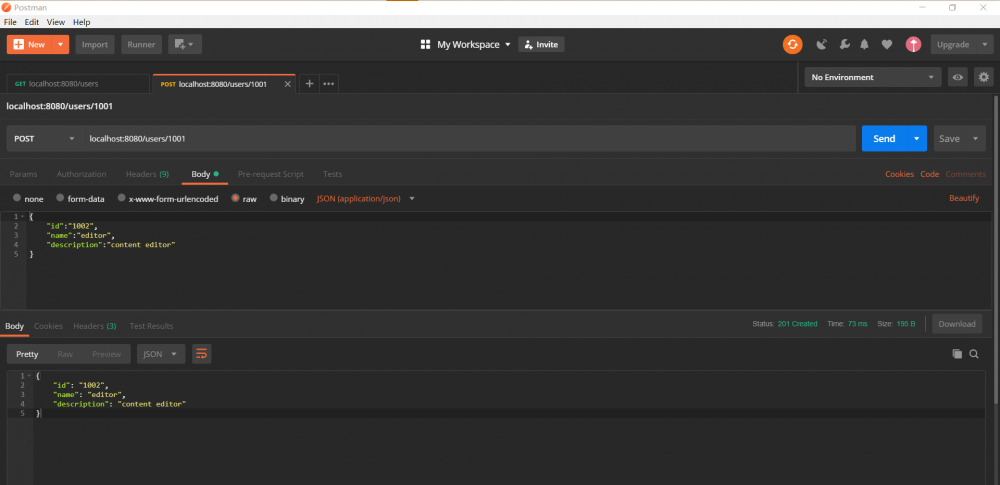
11. 为Post方法提供单元测试用例
在接下来的测试中,我们将使用MockMvcRequestBuilders.post()方法来模拟请求添加用户角色的方法,并使用accept()方法来设置数据格式,另外还需断言请求响应的状态值是否为CREATED且返回的角色信息是否与预期的一致。Post方法的测试源码如下:
@Test
public void addUserRole() throws Exception{
String JSON = "{/"id/":/"1002/",/"name/":/"editor/",/"description/":/"content editor/"}";
RequestBuilder requestBuilder = MockMvcRequestBuilders.post("/users/1001")
.accept(MediaType.APPLICATION_JSON).content(JSON)
.contentType(MediaType.APPLICATION_JSON);
MvcResult result = mockMvc.perform(requestBuilder).andReturn();
MockHttpServletResponse response = result.getResponse();
Assert.assertEquals(HttpStatus.CREATED.value(),response.getStatus());
String expected = "{/"id/":/"1002/",/"name/":/"editor/",/"description/":/"content editor/"}";
logger.info(result.getResponse().getContentAsString());
JSONAssert.assertEquals(expected,result.getResponse().getContentAsString(),false);
}
最后,我们执行此测试用例方法,观察测试结构:

通过图我们可以看到,Post方法已成功通过测试。
今天的课程分享到这里就结束了,在本次课程中,给出了如何测试Rest Controller的方法,同时还使用Postman来进行辅助测试。所有的测试都达到了预期的测试效果。
原文: https://www.ramostear.com/art...
- 本文标签: https UI CTO 缩小 bean equals 测试 git 配置 需求 参数 Service ArrayList web map 代码 REST http Spring Boot java ip cat GitHub SpringMVC entity id spring servlet 数据库 API list src Master rmi description RESTful value build IO 2019 maven find IDE json Java类 ORM junit 自动化 js 数据 App final 业务层 单元测试 源码
- 版权声明: 本文为互联网转载文章,出处已在文章中说明(部分除外)。如果侵权,请联系本站长删除,谢谢。
- 本文海报: 生成海报一 生成海报二











![[HBLOG]公众号](https://www.liuhaihua.cn/img/qrcode_gzh.jpg)

